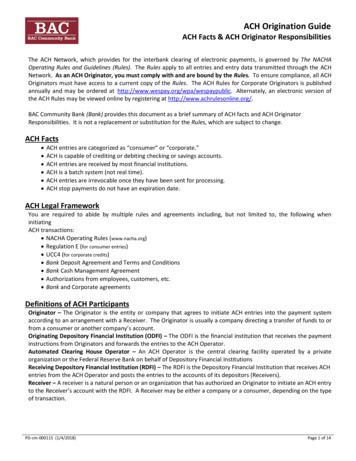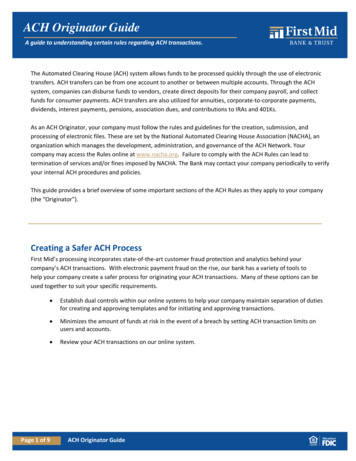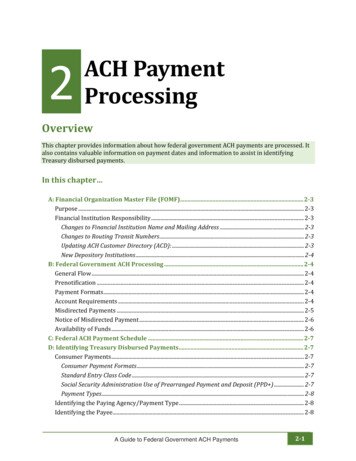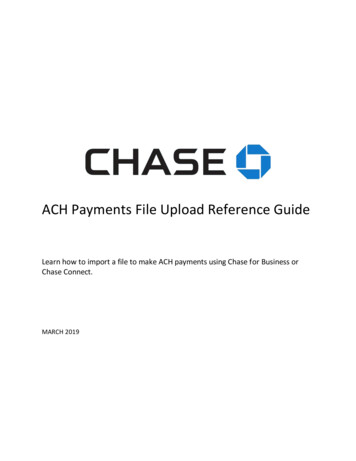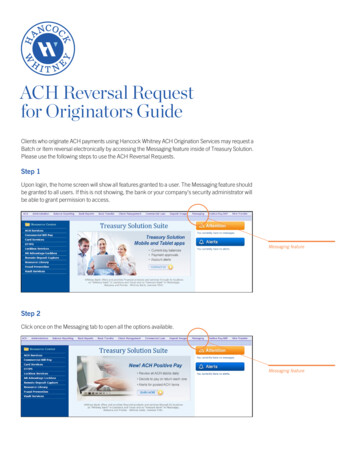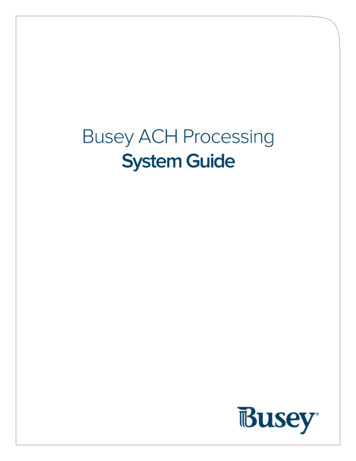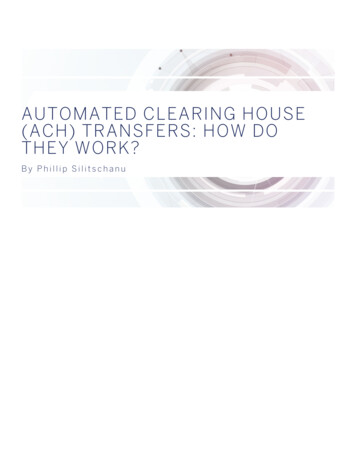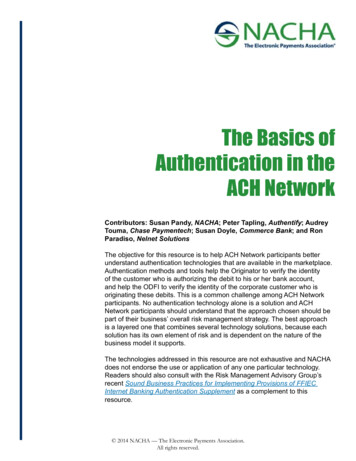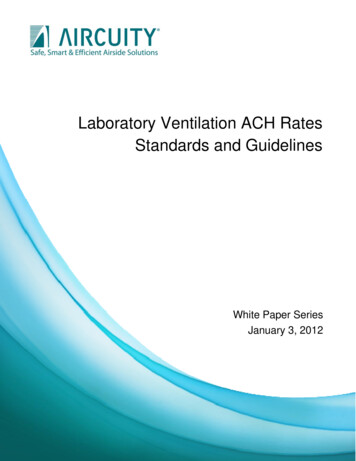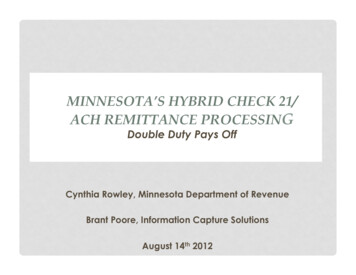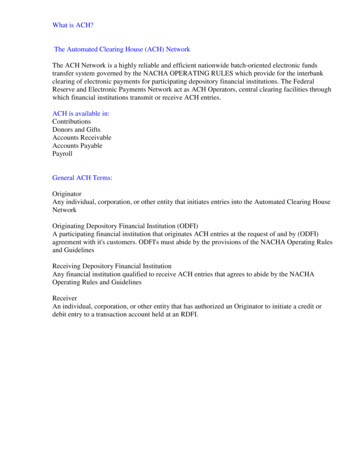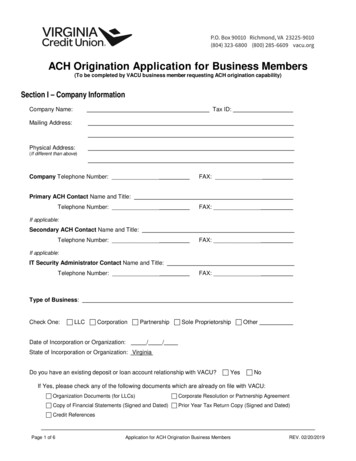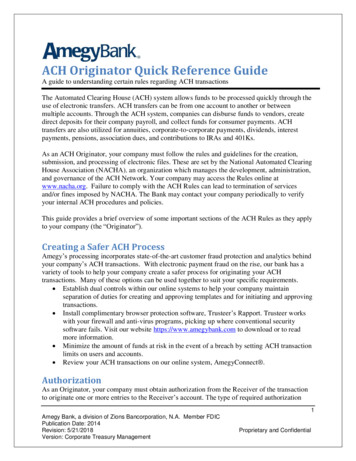
Transcription
ACH Originator Quick Reference GuideA guide to understanding certain rules regarding ACH transactionsThe Automated Clearing House (ACH) system allows funds to be processed quickly through theuse of electronic transfers. ACH transfers can be from one account to another or betweenmultiple accounts. Through the ACH system, companies can disburse funds to vendors, createdirect deposits for their company payroll, and collect funds for consumer payments. ACHtransfers are also utilized for annuities, corporate‐to‐corporate payments, dividends, interestpayments, pensions, association dues, and contributions to IRAs and 401Ks.As an ACH Originator, your company must follow the rules and guidelines for the creation,submission, and processing of electronic files. These are set by the National Automated ClearingHouse Association (NACHA), an organization which manages the development, administration,and governance of the ACH Network. Your company may access the Rules online atwww.nacha.org. Failure to comply with the ACH Rules can lead to termination of servicesand/or fines imposed by NACHA. The Bank may contact your company periodically to verifyyour internal ACH procedures and policies.This guide provides a brief overview of some important sections of the ACH Rules as they applyto your company (the “Originator”).Creating a Safer ACH ProcessAmegy’s processing incorporates state-of-the-art customer fraud protection and analytics behindyour company’s ACH transactions. With electronic payment fraud on the rise, our bank has avariety of tools to help your company create a safer process for originating your ACHtransactions. Many of these options can be used together to suit your specific requirements. Establish dual controls within our online systems to help your company maintainseparation of duties for creating and approving templates and for initiating and approvingtransactions. Install complimentary browser protection software, Trusteer’s Rapport. Trusteer workswith your firewall and anti-virus programs, picking up where conventional securitysoftware fails. Visit our website https://www.amegybank.com to download or to readmore information. Minimize the amount of funds at risk in the event of a breach by setting ACH transactionlimits on users and accounts. Review your ACH transactions on our online system, AmegyConnect .AuthorizationAs an Originator, your company must obtain authorization from the Receiver of the transactionto originate one or more entries to the Receiver’s account. The type of required authorization1Amegy Bank, a division of Zions Bancorporation, N.A. Member FDICPublication Date: 2014Revision: 5/21/2018Version: Corporate Treasury ManagementProprietary and Confidential
ACH Origination Guidevaries by the entry types and parties involved. Authorizations must be retained for at least twoyears following the termination of the authorization. As an Originator, your company must beable to provide the Proof of Authorization (POA) within 5 business days of a request. Yourcompany can customize the authorization to fit your specific application needs, but it must bereadily identifiable as a payment authorization and, at a minimum, include the following: Acknowledgement that entries must comply with laws of the United States Statement authorizing Originator to initiate credit or debit entries Account number and routing number of accounts Identification of account type (checking, savings, loan, etc.) Provisions for termination of the authorization, including any policies for automatictermination in the case of excessive returns or member abuse or termination of loanpayment debits when the loan has been paid in full Individual identification number Date and signatureYour company will find sample authorization forms and information about how the authorizationrules apply to your transactions in the NACHA Operating Rules and Guidelines.Prenotification ProcessThe prenotification process can help your company ensure the data in your file is accurate priorto sending live dollars. Use of the prenotification process is optional; however, when anOriginator initiates a prenote to a receiver, it must do so at least three banking days beforeinitiating the first live dollar electronic transaction to that receiver.If a response is not received by the end of the third day, your company may initiate livetransactions. If your company receives a Return or Notification of Change (NOC), your companymust correct your records prior to initiating live dollar transactions. Your company may chooseto submit another prenote file after making your corrections; however, this is not required.The prenotification transaction codes differ from other entry codes. The following chart includescommon transaction codes by account and transaction type:Account and Transaction TypeChecking Account CreditChecking Account DebitSavings Account CreditSavings Account DebitGeneral Ledger CreditGeneral Ledger DebitLoan Account CreditReturn/NOC21263136414651Normal megy Bank, a division of Zions Bancorporation, N.A. Member FDICPublication Date: 2014Revision: 5/21/2018Version: Corporate Treasury ManagementProprietary and Confidential
ACH Origination GuidePlease refer to the NACHA Operating Rules and Guidelines for more information on theprenotification process.ACH File LimitsAn ACH exposure limit may be established for each originator. This limit is calculated based onyour company's expected volume, along with credit worthiness. If an originator submits a filethat causes the exposure limit to be exceeded, the file may be suspended, deleted, or requirespecial approval for transmittal.ACH PrefundingYour service agreement may state that your use of the ACH module is subject to ACHPrefunding. If this is the case, to ensure that adequate funds are available for requestedcredits/payments, as a general rule, the Bank will debit the offset account for the full amount ofyour batch, two (2) days prior to processing the transactions. Insufficiently-funded batchessuspend until sufficient funds become available in the funding account. If sufficient collectedfunds are not available before processing begins on the evening before the settlement date of thebatch, the batch may not be processed. Prefunding can be used only when sending credits.Same Day ACHThe NACHA rule provides to you the option to send same day ACH transactions to accounts atany Receiving Depository Financial Institution (RDFI).All RDFI’s must receive same day ACH transactions.The Same Day ACH Rule became effective September 23, 2016 in three phases: Phase 1 - Sept. 23, 2016: Option for same day credits (e.g. payroll direct deposit). Fundsmust be available by the end of RDFI’s processing day. Phase 2 - Sept. 15, 2017: The option for same day debits becomes available (e.g.recurring automatic bill payments). Phase 3 - March 16, 2018: Same day funds are available to the recipient (e.g. payrolldirect deposit) by 5:00 PM based on the RDFI’s local time.Same Day Eligibility: Eligible items: All domestic ACH transactions up to 25,000 (PPD, CCD, etc.) Includes Prenotes, Notifications of Change (NOC), & Zero Dollar Remittance Ineligible items: International ACH Transaction (IAT) entries Entries over 25,000ACH transactions submitted to the Bank by the posted cutoff time, meeting the eligible itemsrequirement and having a same day (todays’ date) as the Effective Entry Date will be processedas a Same Day Entry. Same Day entry fees will apply.3Amegy Bank, a division of Zions Bancorporation, N.A. Member FDICPublication Date: 2014Revision: 5/21/2018Version: Corporate Treasury ManagementProprietary and Confidential
ACH Origination GuidePlease note: ACH transactions submitted to the Bank with stale or invalid Effective Entry Dateswill be settled at the earliest opportunity, which could be the same day. The Bank recommendsall effective dates are reviewed prior to submitting your ACH file.ACH Deletion/ReversalACH Originators sometimes determine that they need to delete an entry after the transaction hasbeen distributed. Distributed transactions can be reversed at the file, batch, or transaction level.The word “REVERSAL” must be in the Company Entry Description Field of the Batch HeaderRecord.NOTE: Reversals do not guarantee that the funds will be returned to the Originator. It isimperative that credit Originators take special care to ensure that no transactions are sentto unintended receivers.A reversal can only be executed within five banking days after the settlement date. Whenyour company requests the reversal of a transaction, NACHA Rules require that your companynotify the receiver of the reversing entry and provide the reason for the reversing entry to thereceiver’s account.If your company uses the Direct Send/Transmission method for submitting ACH files, pleaserefer to the NACHA Operating Rules and Guidelines - ACH Record Format Specifications forassistance with the components of your reversal file.Submitting a Reversal/Deletion RequestPlease contact Treasury Management Customer Service for assistance in processing theserequests at (713) 235-8805 or treasurymanagement@amegybank.comFor same-day processing, reversal/deletion requests must be received by Amegy Bank bypublished bank cutoff time within five (5) business days of the settlement date.Your company may submit reversal requests in writing using the Deletion/Reversal form.AmegyConnect ACH users may also submit reversal requests through AmegyConnect .Notifications of Change (NOC)A Notification of Change is a non-monetary transaction by which an RDFI (ReceivingDepository Financial Institution) notifies an ODFI (Originating Depository Financial Institution)that information contained in an entry the RDFI has received and posted has become outdated orthat information contained in a prenotification is incorrect. The entry must be transmitted to theODFI within two banking days of the settlement date of the entry. The Originator must makethe changes specified in the NOC within six banking days of receipt of the NOC information(or prior to initiating another entry to the Receiver's account, whichever is later).NOTE: Non-compliance could result in NACHA rules violations and associated fines.4Amegy Bank, a division of Zions Bancorporation, N.A. Member FDICPublication Date: 2014Revision: 5/21/2018Version: Corporate Treasury ManagementProprietary and Confidential
ACH Origination GuideThe most common NOC reasons are listed below. A full listing can be found in the NACHAOperating Rules – Notification of Change.CODEC01C02C03C13DESCRIPTIONIncorrect DFI Account NumberIncorrect Routing NumberIncorrect Routing Number and Incorrect Account NumberAddenda Format ErrorReturn EntriesA return entry occurs when the RDFI (receiving bank) or Receiver rejects a transaction yourcompany has originated. Most returns are received within 48 hours of the transaction’s originalsettlement date and create a reversing entry to originator’s deposit account. Consumers are ableto return unauthorized transactions up to 60 days from the statement date. The most commonreturn reasons are listed below. A full listing can be found in the NACHA Operating Rules –Return IONInsufficient FundsAccount ClosedNo Account / Unable to Locate AccountInvalid Account NumberReturned Per ODFI RequestAuthorization Revoked by CustomerPayment StoppedUncollected FundsCustomer Advises Not Authorized, Improper or IneligibleCorporate Customer Advises Not AuthorizedCertain ACH rules apply to reinitiating returned transactions. To review these rules, refer to theNACHA Operating Rules and Guidelines.In order to maintain the integrity of the ACH Payments Network, NACHA enforces terminationof services and levies substantial fines for continued violations of rules associated with returns.ACH Returns ReportingAmegy Bank offers options by which your company can receive information about returnedtransactions.Return Item Report delivery options include: Online – using AmegyConnect Data Transmission - formatted in standard NACHA file format5Amegy Bank, a division of Zions Bancorporation, N.A. Member FDICPublication Date: 2014Revision: 5/21/2018Version: Corporate Treasury ManagementProprietary and Confidential
ACH Origination GuideAddenda ReportingElectronic Data Interchange (EDI) reporting gathers addenda information from ACH entries andformats it into either a human-readable report or data file. If the Receiver of the transactionrequests addenda information, your company must first include the information in an addendarecord. Then, the Receiver of the transaction must obtain EDI reporting from their financialinstitution. Origination services are not required to enroll in addenda reporting.If your company does not currently receive this reporting and is interested in this service, pleasecontact Treasury Management Customer Service at (713) 235-8805 ortreasurymanagement@amegybank.com.Deadlines and Cutoff TimesTransactions must be submitted by the cutoff time in order to be processed that day.Transactions submitted after the cutoff time will be processed on the next business day. Whenpossible, files should be submitted two days prior to the settlement date.NOTE: Files submitted with a next day settlement date may not allow time for repair in theevent of a problem in the file or processing.Cutoff times are as follows: ACH origination Reversal/Deletion requests must be submitted no later than 5:30 p.m.CT within five (5) business days of the settlement date. ACH credit and debit files should be submitted before 5:30 p.m. CT and at least twodays before the effective date of the file. Transactions intended for Same Day settlement must be submitted by 12:00 PM CT.Holiday and Weekend Processing“Business days” refer to days the US banking system is open for business. ACH file transfersand other online funds transfers will not be processed on days the bank is closed. Therefore,customers should ensure that settlement dates are not set for days the bank is closed. Our Bankobserves all federal holidays. Federal holidays are listed below. New Year’s DayMartin Luther King, Jr. DayPresidents’ DayMemorial DayIndependence DayLabor DayColumbus DayVeterans’ DayThanksgiving DayChristmas Day6Amegy Bank, a division of Zions Bancorporation, N.A. Member FDICPublication Date: 2014Revision: 5/21/2018Version: Corporate Treasury ManagementProprietary and Confidential
ACH Origination GuideStandard Entry Class (SEC) CodesEach ACH transaction must be accompanied by a three-character identifier referred to as astandard entry class (SEC) code. An SEC code defines how authorization for the transaction wasobtained. Some SEC codes may only be used for transactions sent to a consumer account; othersmay only be used for transactions sent to a business/corporate account. Some codes may be usedfor transactions sent to both types of accounts.NOTE: SEC codes must be used appropriately and in accordance with NACHA Rules.The use of ARC, BOC, IAT, POP, RCK, TEL, and WEB requires an additional writtenagreement with the Bank.The following chart outlines and defines the most common SEC codes being used today in theACH network:SEC CodeConsumer /CorporateDefinitionDebit /CreditARC – AccountsReceivable EntryBothA single-entry debit originated based on an eligible sourcedocument provided to an Originator via the US mail or ata dropbox location.DebitBOC – BackOffice ConversionEntryBothDebitCCD – CorporateCredit or DebitEntryCorporateA single-entry debit originated based on an eligible sourcedocument provided to an Originator at the point-ofpurchase or manned bill payment location for subsequentconversion to an ACH transaction during back-officeprocessing.An entry originated by an organization to or from theaccount of that organization or another organization. Theentry can be monetary or non-monetary.CIE – CustomerInitiated EntryConsumerCOR –Notification ofChangeBothCTX – CorporateTrade ExchangeEntryCorporateIAT –International ACHTransaction**BothPOP – Point ofPurchase EntryBothA credit entry initiated by or on behalf of the holder of aconsumer account to the account of a receiver.A non-monetary transaction that instructs the Originatorof a transaction to change certain information beforereinitiating another transaction to the same receiver (i.e.,change the account number, change the trancode, etc.).An entry originated by an organization to or from theaccount of that organization or another organization. Thistransaction may be accompanied by up to 9,999 lines ofpayment-related addenda information. CTX is mostcommonly used when multiple lines of addenda areneeded.A debit or credit entry that is part of a payment transactioninvolving a financial agency’s office that is not located inthe territorial jurisdiction of the United States.A single-entry debit originated based on an eligible sourcedocument provided in-person to an Originator at thepoint-of-purchase or manned bill payment location forconversion to an ACH transaction at the point-of-purchaseor manned bill payment location.Debit orCreditCreditN/AReturn Timeframe*Administrative: 2banking daysUnauthorized: 60calendar daysAdministrative: 2banking daysUnauthorized: 60calendar daysAdministrative: 2banking daysUnauthorized: 2 calendardaysAdministrative: 2banking daysUnauthorized: 60calendar daysN/ADebit orCreditAdministrative: 2banking daysUnauthorized: 2 calendardaysDebit orCreditAdministrative: 2banking daysUnauthorized: 60calendar daysAdministrative: 2banking daysUnauthorized: 60calendar daysDebit7Amegy Bank, a division of Zions Bancorporation, N.A. Member FDICPublication Date: 2014Revision: 5/21/2018Version: Corporate Treasury ManagementProprietary and Confidential
ACH Origination GuidePPD – PrearrangedPayment &Deposit EntryConsumerAn entry originated by an organization to a consumeraccount based on a standing or single-entry authorizationfrom the receiver of the transaction.Debit orCreditRCK – Represented CheckEntryBothA debit entry used to collect the amount of a checkreturned for insufficient or uncollected funds.DebitTEL – TelephoneInitiated EntryBothA debit entry originated based on an oral authorizationprovided to the Originator by a receiver via the telephone.DebitConsumerA debit entry originated based on (1) an authorization thatis communicated, other than by an oral communication,from the receiver to the Originator via the Internet or awireless network; or (2) any form of authorization if thereceiver’s instruction for the initiation of the individualdebit entry is designed by the Originator to becommunicated, other than by an oral communication, tothe Originator via a wireless network.A debit entry initiated to collect an eligible item that iscontained within a cash letter that has been lost,destroyed, or is otherwise unavailable to the originatingbank.DebitWEB –Internet/MobileInitiated EntryXCK – DestroyedCheck EntryBothDebitAdministrative: 2banking daysUnauthorized: 60calendar daysAdministrative: 2banking daysUnauthorized: 60calendar daysAdministrative: 2banking daysUnauthorized: 60calendar daysAdministrative: 2banking daysUnauthorized: 60calendar daysAdministrative: 2banking daysUnauthorized: 60calendar days* Return timeframes listed in this table may vary depending on certain circumstances surroundingthe transaction. For a complete guide on return timeframes, please refer to the NACHA OperatingRules & Guidelines.**International ACH Transactions (IAT) are possible; however, they must be kept separate fromdomestic transactions. For a complete list of IAT countries, please contact your TreasuryManagement Customer Support. Both credit and debit transactions can be sent to Canada. Theprocessing requirements and schedules for these transactions differ from normal domestictransactions. Please contact your Treasury Management representative or Relationship Managerfor more information.Addition
For same-day processing, reversal/deletion requests must be received by Amegy Bank by published bank cutoff time within five (5) business days of the settlement date. Your company may submit reversal requests in writing using the Deletion/Reversal form. AmegyConnect ACH users
